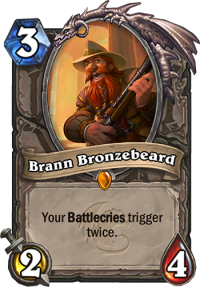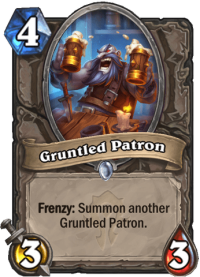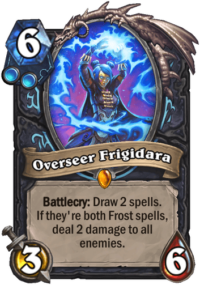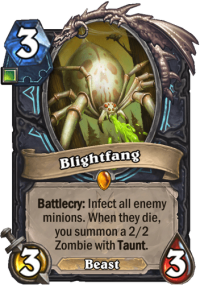The launch of a new class in Hearthstone is always a major event. Death Knight is the second new class to enter the fray, and it is by far the most popular class in the game, but it is already clear that this new class is no Demon Hunter. I guess that’s good. Demon Hunter forced several emergency nerfs, as it simply obliterated the field. Death Knight’s Obliterate is not even good enough to see play. The big question now is will Death Knight as a class see any play after the initial hype?

Death Knight had a decent start, to be honest. Blood Death Knight was posting above 60% win rates on day one. The class is fun and well-rounded. The Corpse mechanic is balanced and interesting. Blood can be a defensive powerhouse. Unholy knows its way around tokens. Frost has some powerful burst damage.
However, no Death Knight deck can do broken things. And to do broken things is the way to success in constructed Hearthstone. You want to play Brann Bronzebeard with Shockspitters. You want to play Brann Bronzebeard, Anub'Rekhan, and Astalor Bloodsworn‘s final form. You want to play a flurry of cards into Necrolord Draka. Death Knight does not do any of those things.
Death Knight would be a tyrant in the old era of Hearthstone when games were fair and you could play for an incremental advantage. As a matter of fact, Death Knight is a ferocious meta-tyrant right now in Arena. Hearth Arena’s stats show that more than 90% of all 12-win Arena runs during March of the Lich King have been accomplished with Death Knight. Picking up double Frost and single Unholy early in your Arena deck-building is a recipe for unparalleled success. You just need to find that Death Knight class offered to you first.
When it comes to Standard, Death Knight is struggling. What can Death Knight do about it?
Death Knight Combo: Gruntled Patrons
Well, that did not last! Blizzard has banned Gruntled Patron and Grim Patron from Standard and Wild after we published this article while they figure out what to do with this combo that can activate minutes of animations.
Death Knight is trying to find something broken and bursty. Early on, Frost seemed to be in the best position to do that, but there are also some hilarious things you can pull off with Blood. Let me present, the Blood Gruntled Patron combo deck!

The idea behind this combo is to use Gruntled Patron together with Corpse Explosion. The result: several minutes of explosions as Patrons generate more Patrons, die, generate Corpses that keep the explosion going, and repeat until they hit the event cap. The long time it takes is unfortunate, as there is a noble goal behind all this: pumping up Sire Denathrius to 60+ damage so that it can end the game on turn 10.
It’s one way to end the game as a Blood Death Knight, but it is a two-turn combo that can be done on turns nine and ten at the earliest, so it is not exactly the fastest deck on the block.
Blood Death Knight
News: Blizzard has nerfed Sire Denathrius to Infuse (2) after we published this article. First impression: I expect the card to be dropped from Blood Death Knight, as they will not have enough minions to make it big. It may still be relevant for Unholy.
The best-performing Blood Death Knight deck on the first day of the expansion was the list I built for our theorycrafting article:
However, the popularity of Blood has proven to be meta-defining, and this Blood list has not been up to the task. The deck can beat most aggro decks and take on many midrange decks as well, but it can be attacked in multiple ways: Ramp Druid can simply overpower Blood, No-minion Demon Hunter can keep dealing damage with a minimal board presence that eliminates Blood’s best responsive cards, and Arcane Hunter can combo Blood down fast enough before the Health total grows out of control.
Compared to the other day-one decks, the list has been the most durable, but with some minor changes, it can be improved.
Here is the current top performer according to HSReplay stats:

This list cuts some of the early game from the original, as it ditches one copy of Heart Strike and both Soulbreakers. It also cuts the Silence tech card Smothering Starfish, as it turns out that people play less for the board specifically because of Blood Death Knight.
The new additions are more Discovery in the form of Nerubian Viziers, generation with Zola the Gorgon (an oversight to be omitted originally, for sure), and card draw with Famished Fool.
This enables the deck to fight better against opponents who are not playing for the board as much and Discover key tools for the matchups in time. The changes clearly help against No-minion Demon Hunter and Arcane Hunter, turning the matchups from unfavored to roughly even. However, nothing seems to help against Ramp Druid. Blood Death Knight might just not have the tools to fight against that archetype, but getting rid of some unfavored matchups already surely helps.
I do not think the evolution of Blood Death Knight ends here, either. In particular, Famished Fool is disappointing in this list, and the deck does not necessarily need all the Discover tools that are currently included. A Nerubian Vizier could easily make space for something better. So, there is some space for relevant tech cards as the meta stabilizes, which can further improve the performance of the deck. I just don’t see any way to reliably beat Druid with this.
Frost Death Knight
Frost Death Knight is the spec most pros were excited about before March of the Lich King launch. This is not surprising, as Frost offers plenty of intense gameplay. Many pro players like to draw and play a lot of cards, so a deck that rewards activity is something they typically look forward to.
Frost got off to a good start on day one, but it crumbled even faster than Blood. The most lasting approach to Frost has been Feno’s Renathal Burn deck:

While the win rate of this deck fell to around 50% already on the second day, it has managed to stay there ever since. Frost can burn down opponents, and the 40 Health provided by Renathal has proven to be crucial in making Frost survive long enough to find its damage cards.
Frost is clearly stronger than Blood against Arcane Hunter, but it lacks the damage to finish games against Blood and it is even more abysmal against Druid. If Blood’s 30-70 matchup against Druid is scary, Frost’s 20-80 against Druid is similar to the old Freeze Mage vs Control Warrior matchup, which was long the epitome of an unwinnable matchup.
Furthermore, it is not obvious how to improve Frost. Blood has some free space in the deck to add a tech card or two against an established meta, but it is more difficult to fix Frost’s issues with simple tech cards. Bloodmage Thalnos and Talented Arcanist are generally the weakest cards in the deck, but there are no obvious replacements that would upgrade Frost to a new level.
Frost is playable, but not great. Perhaps that is the overall story of Death Knight.
Unholy Death Knight
While most of the hype has been on Frost and Blood, Unholy has been flying under the radar. The sample sizes of Unholy decks are still low, which adds considerable uncertainty to evaluating their performance. The best lists look like they could be the best Death Knight decks, but Blood lists are within the margin of error of their win rate figures.
At the moment, the best-performing Undead Death Knight deck is this Renathal deck:

Unholy Death Knight makes extensive use of tokens, but it seems to lack the capability for pure aggression. At least so far, the most aggressive Unholy Death Knight decks have not been able to perform well. The severe lack of powerful one-cost Undead minions that work well when played on the first turn is one possible factor in this.
From this perspective, using Prince Renathal makes perfect sense. You have a bit more Health to be able to pressure the opponent over the course of a longer game.
Unholy nonetheless clearly differs from the other Death Knight archetypes. For example, Famished Fool, which has been disappointing in Blood Death Knight is right at home in Unholy. I also believe that Unholy has more opportunities for refinement. Bonedigger Geist is the most disappointing card in the above list, and Irondeep Trogg is unable to shine in it either.
Inspiration for upgrades can be sought from other Unholy decks. The list I built for our Unholy Death Knight theorycrafting article is the second-best deck of the archetype, this one is without Renathal:
It will be interesting to see whether a Renathal or a non-Renathal list will come out on top once the decks are fully refined. Grabbing some of the best performers from this list to the Renathal list could already improve things. In particular, Astalor Bloodsworn and The Scourge are excellent cards that are still missing from the Renathal list and should definitely be added there.
It is more difficult to find clear improvements to my list. Arms Dealer is the worst-performing card there, but the deck will have a severe lack of one-drops if it is cut. There are no great replacements available. Famished Fool could do great things, but may be too slow without the extra Health from Renathal. Blightfang is a good fit in the Renathal list, but it is too slow in the other non-Renathal lists that try to use it.
Overall, I think the Renathal list has greater potential for improvement, as it is still missing some obviously strong cards and it can better deal with a slow start caused by the lack of early-game Undead minions.
The Future of Death Knight
Well, one thing is for sure. Death Knight will not need nerfs similar to the Demon Hunter nerfs of 2020. Death Knight is a problem class in Arena, but that should be possible to address by adjusting the offering rates of cards. Especially so, because Death Knight cannot take any nerfs in Standard unless other decks are nerfed first.
There is still room to improve all Death Knight archetypes. Blood can be teched against the meta once things are stable enough. Unholy has plenty of unexplored space left. Frost is a little trickier, I admit.
What is interesting, and maybe slightly concerning, is that all the current playable Death Knight decks go all-in on a single rune type. It’s triple Blood, triple Frost, and triple Unholy. Before the expansion’s release, Blizzard gave the impression that there are ten possible varieties of Death Knight, and most of them should be competitive. So far, only the pure-bred variants have succeeded.
One can argue that the huge payoffs given by the triple-rune cards make deck-building for these decks much easier, and 2-1 variants will start to appear later on as people get more accustomed to the meta and are able to start targeting specific decks. Alternatively, the huge payoffs from triple-rune cards are so overwhelming that 2-1 decks cannot overcome them. We will see in the coming weeks.
Anyway, I believe there is still enough unexplored space left in Death Knight that the class will be part of the meta in this expansion. Right now, it does not look like a top-tier choice, but as it is new and different, being playable would be enough to ensure that it will be seen on the ladder, even after the initial hype wears off.
Leave a Reply
You must be logged in to post a comment.







































































Are there any statistics on its win % in Arena, It seems awfully Strong borderline dominant in arena. I have 12 , two 11 and a 10 win run in 6 arenas with DK. Against DK playing as other classes I have a win % of 28% and against all other classes with those same decks I have a 61% win rate.
Honestly playing death knight felt so underwhelming on day 1 that I would rather prefer if it was like demon hunter launch day 1. At least we got to actually play with (and against) the new cards and new class and explore all that new stuff with demon hunter. This time I’m pretty sure that everyone just played a few games with dk, understood that it’s not op by any means and moved on to explore new cards for other classes.
Have to agree with all of this. The class just feels like it comes up short and definitely doesn’t have those “OH MY GOD” turns – although Lord Marrowgar is SCARY when you set it up right. But like you said, Unholy is SLOW. (And shouldn’t that Stitched Giant *seem* like it should be depending on Undead summoned vs. corpses spent?)
To me, it seems like instead of going brute force power like they did with Demon Hunter to make people play the class, they went for variety in building the class instead. It’s cool and novel to be sure, but the class identity just feels… slow. It’s like they went in a lot of different directions but didn’t hone any to perfection.